 This month’s interview is with Darshana Khiani, a San Francisco Bay area author, engineer, and advocate for South Asian children’s literature. In her own words, she’s “infinitely curious about the world and enjoys sharing my findings with young readers. If I can make a child laugh, even better.”
This month’s interview is with Darshana Khiani, a San Francisco Bay area author, engineer, and advocate for South Asian children’s literature. In her own words, she’s “infinitely curious about the world and enjoys sharing my findings with young readers. If I can make a child laugh, even better.”
Darshana has authored a picture book, How to Wear a Sari, and she has two more coming out in 2023. She’s also a South Asian kidlit advocate, helping to spread the word of wonderful new South Asian kidlit books.
In addition to being a wife and a mom to two girls and one dog, she’s also created a wonderful list of Favorite Firsts.
- Favorite first friend: Sigrid
- Favorite first color: lavender
- Favorite first food: pizza and pav bhaji (kind of like a vegetarian sloppy joe)
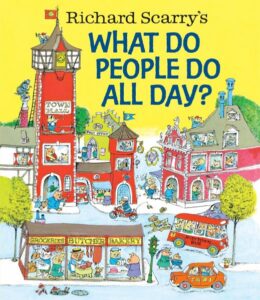 Favorite first book: Richard Scarry. I still love What Do People Do All Day.
Favorite first book: Richard Scarry. I still love What Do People Do All Day.- Favorite first subject in school: Math (ironically English was my worst…but I loved creative writing!)
- Favorite first song: The Tide is High by Blondie
- Favorite first trip: Kenya
What a list, right? Let’s find out even more about Darshana with this interview!
RVC: Fewer than half of the authors I interview are full-time writers. Where does writing fit into your typical workday?
DK: I am a full-time engineer working in high-tech with a family and a dog. So, writing takes places early in the mornings or late at night or anywhere in-between I can find time.
RVC: How has that relationship changed over the years?
DK: I adjust my writing times around my other responsibilities. When I first started, I would take my writing bag to my kids’ practices or write late at night. Now, I tend to write first thing in the morning and on weekends, sometimes during lunch.
RVC: At what point in your life did you first consider yourself to be a writer?
DK: Probably a few years in.
RVC: You ran a blog about children’s books for a long time before you got your own debut picture book published. How did that work inform or help your own writing?
DK: The blog, Flowering Minds, was a great way for me to talk about and recommend books which I love to do. I knew that writers had to read voraciously, so why not be a resource and give recommendations along the way? By reading a lot, it helped me focus on writing stories that hadn’t been done before.
RVC: You’re a champion of South Asian kidlit. What’s the latest report on the state of that as of today?
DK: Thank you for asking. I am floored by the number of books coming out every season by South Asian creators. When I started compiling the lists back in 2016, there were less than 5 South Asian picture books those first two years. Now there are at least 5 picture books a season!
In novels, there is such a variety of books from contemporary, historical fiction, fantasy, mystery, and rom-com. Now all we need is some suspense and horror 😉 and older non-fiction.
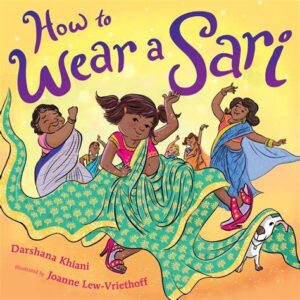 RVC: Your debut picture book is a wonderful addition to the world of South Asian kidlit. What’s the story behind How to Wear a Sari?
RVC: Your debut picture book is a wonderful addition to the world of South Asian kidlit. What’s the story behind How to Wear a Sari?
DK: When I started writing picture books, I wanted to write books for second-generation South Asians like my two daughters. Books that centered their lives in this country. Books that had universal themes about growing up with a South Asian backdrop and a touch of humor.
In the summer of 2016, I was studying 2nd-person POV picture books for a different writing project. I love the elegance and sophistication of saris. However, I’m not the best at wearing them. It can take me upwards of 45 minutes to drape one. I started wondering if it’s this hard for me to wear a sari then what would it be like for a young Indian girl. That was the seed for How to Wear a Sari. A sari can be stylish, sophisticated, a symbol of womanhood in South Asian culture much like wearing high-heels or a long fancy gown is in Western culture.
RVC: Why is the sari so important to South Asian culture?
DK: There are so many varieties of materials, designs, and draping styles. Much of it is unique to the region where the sari was made. It is an expression of identity. Saris span the range from simple cotton ones worn every day while tending house to fancy, elaborate ones for special occasions.
RVC: Back to your book! How to Wear a Sari has an especially resonant ending. At what stage in the drafting process did that emerge?
DK: I knew from the beginning that she was going to run and fall, and that was the original ending. Over the revision process, the fall scene became the climax, and the ending became the spread about getting in trouble with mom. But that left the story on an emotional down note, so I brainstormed possible endings. I came up with the photo album of flops to honor the challenges and spills kids and even adults have when trying new things. I loved it since it felt fresh and brought in another layer to the story.
RVC: As a writer, what was the most valuable lesson you took from this book?
DK: I love the story voice by using a direct narration approach, however, it is a challenge to get character emotion across. Joanne’s artwork is so expressive and was a perfect match for the text.
RVC: You’ve got another picture book coming out in a few weeks. What’s the elevator pitch?
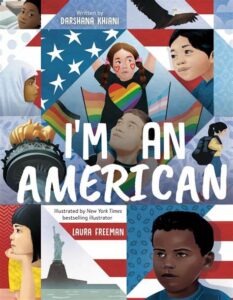 DK: A classroom full of diverse students discusses what it means to be American. They show that in spite of our varied backgrounds and experiences it is our shared American values that bring us together.
DK: A classroom full of diverse students discusses what it means to be American. They show that in spite of our varied backgrounds and experiences it is our shared American values that bring us together.
RVC: What are you most proud about regarding I’m an American?
DK: That I was able to capture the vision I had on paper. It’s a book for all ages 8 and up. For younger readers, it might be the first time they hear a particular group’s immigration story, while for older readers they might see an event through a new lens. What I hope above all is that readers will look beyond the differences on the surface and realize our shared humanity.
I love Laura’s stunning artwork with layered images.
RVC: Which of Laura Freeman’s illustrations most knocked your socks off?
DK: Probably the Somali and Russian Jew spreads. There is no way NOT to be moved by them. I do like the joyous spread of the Pride parade, too.
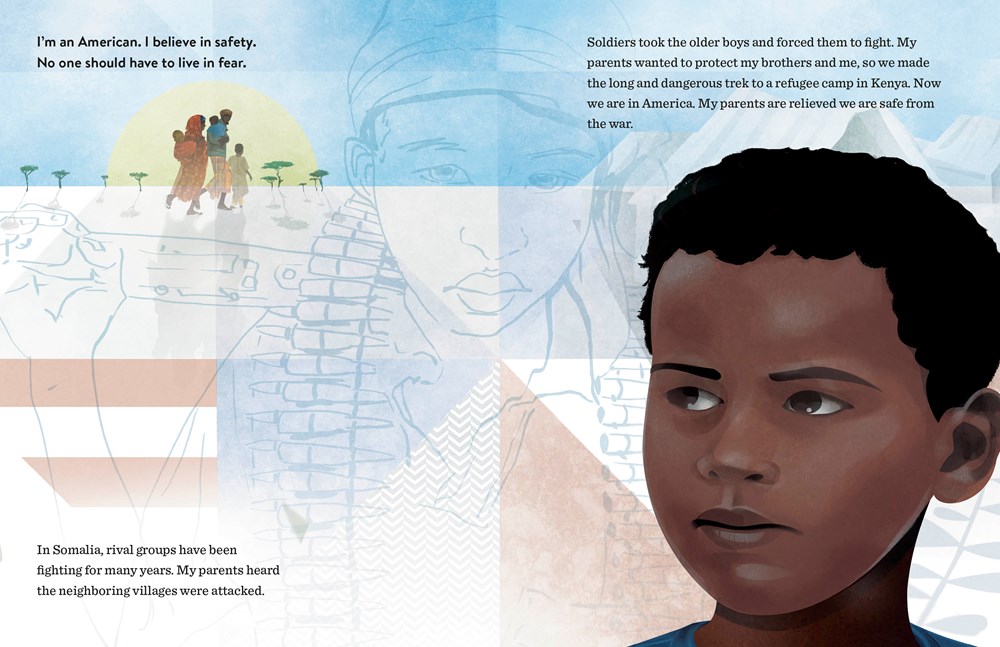
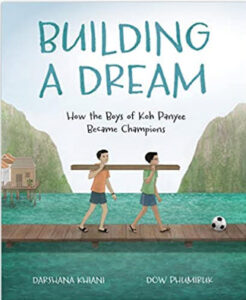 RVC: Now, you’ve got yet another book coming out later in 2023—Building a Dream: How the Boys of Koh Panyee Became Champions. What’s the most important thing people should know or understand about that?
RVC: Now, you’ve got yet another book coming out later in 2023—Building a Dream: How the Boys of Koh Panyee Became Champions. What’s the most important thing people should know or understand about that?
DK: I loved how the boys faced their environmental and societal challenges with perseverance, hope, and ingenuity.
RVC: In what ways does that book showcase your growth as a writer?
DK: Actually, of my three books, this one was written before the other two. The story I’m an American is my most “recent” story. It’s the first story I ever did with layered text, substantial backmatter, lots and lots of research, and an eye on sensitivity the entire time.
RVC: Let’s move to talking about bigger things. Stylistically speaking, how do you describe your writing?
DK: I have no idea. Maybe my readers know. 😉
RVC: Talk a bit about your writing and revision process.
DK: I hate writing first drafts. I have a really strong left-brain editor, probably because I’m an engineer, so those first drafts feel near impossible. However, I do love revising except when I have to take a polished story and break it into pieces and start all over–that may actually be harder than writing a first draft. One of my favorite parts of revising is collecting peer feedback and then copying down the notes with different colored pens into various categories and then methodically making the revisions that resonate.
RVC: Tell me about a time where your writing career didn’t go the way you wanted.
DK: I don’t know if there is a specific thing that didn’t work out. The writing journey is a windy one with ups & downs and twists & turns. But I believe everything happens the way it’s supposed to. I did think my writing career would be progressing a little faster. When I started back in 2011, I had no idea it would take seven years before I got my first book deal.
RVC: Since COVID-19, I try to ask a health and wellness question during each interview. Here’s yours. What do you do to de-stress?
DK: Eat dark chocolate, go for a walk, talk to my sister, or watch a pick-me-up TV show (nothing too serious).
RVC: One final question for this part of the interview. What’s something upcoming that you’re really excited about or really want to promote?
DK: I run a South Asian kidlit quarterly newsletter. I feature the upcoming season’s South Asian kidlit books, picture books through young adult. I have been doing this for nearly eight years. It is wonderful to see the quantity and diversity of stories coming out. Folks can check-out my South Asian kidlit page to see past lists.
RVC: Alrighty, Darshana. Let’s leap into the LIGHTNING ROUND. The point values are quintupled but we’ve only got sixty seconds. Are you ready?
DK: Fire away!
RVC: What’s the funniest word in the English language?
 DK: ugh (no, that’s not the word, my mind is a blank)… hmmm… hullabaloo
DK: ugh (no, that’s not the word, my mind is a blank)… hmmm… hullabaloo
RVC: If you could travel back in time, what year would you choose to go to?
DK: Victorian Era.
RVC: Would you rather have a personal chef, a maid, or a masseuse?
DK: You mean I can’t have all there?!?! Okay, a chef since I enjoy eating but not cooking.
RVC: Which author sets the standard for South Asian kidlit?
DK: There are so many talented authors and illustrators that are pushing the boundaries and carving new paths in different ways. The South Asian community is a diaspora spread around the world with varying degrees of commonality and nuanced experiences amongst the sub-groups.
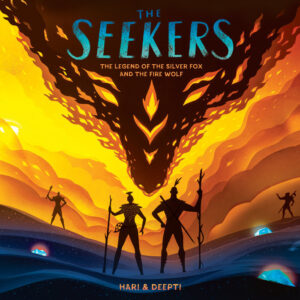 Here are some of the creators I enjoy.
Here are some of the creators I enjoy.
Hari & Deepti’s light box art. Intricate and ethereal! They have done a picture book as well as book covers.
Mitali Perkins, Sabaa Tahir, Samira Ahmed, Rina Singh, Padma Venkatraman, and Rajani LaRocca.
RVC: What’s the best picture book you’ve read in 2022 that deserves a lot more love than it’s gotten?
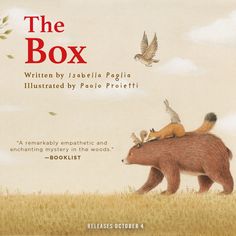 DK: I recently read The Box by Isabella Paglia and Paolo Proietti and translated by Laura Watkinson. This book was first published Italy and released in English in the U.S. in Jan 2020. I only heard about it recently. It’s sweet and heart-warming and is all about helping a newcomer and meeting that person where they are and patience.
DK: I recently read The Box by Isabella Paglia and Paolo Proietti and translated by Laura Watkinson. This book was first published Italy and released in English in the U.S. in Jan 2020. I only heard about it recently. It’s sweet and heart-warming and is all about helping a newcomer and meeting that person where they are and patience.
RVC: What’s your picture book philosophy in five words or fewer?
DK: Follow your curiosity!
RVC: Love it. Thanks so much, Darshana!

